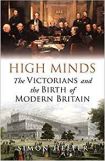High Minds: The Victorians and the Birth of Modern Britain by Simon Heffer
| High Minds: The Victorians and the Birth of Modern Britain by Simon Heffer | |
|
| |
| Category: History | |
| Reviewer: John Van der Kiste | |
| Summary: An in-depth study of the social, political and intellectual changes that took place in and transformed Britain between 1840 and 1880 | |
| Buy? Yes | Borrow? Yes |
| Pages: 878 | Date: October 2013 |
| Publisher: Random House | |
| ISBN: 9781847946775 | |
|
| |
Between 1840 and 1880 British life and society underwent a gradual but major change. Young adults in the latter year would have seen a very different country from that in which an earlier generation came to maturity. The land in which poverty, disease, squalor and injustice were endemic, and in which the Chartists had agitated for fairer rights for all, had been largely transformed by the modernising factors of social upheaval and industrial change.
In his preface, Heffer defines his aims in this lengthy book (over 800 pages of text) as part social, part intellectual, and part political history of this transition period. Rather than presenting a chronological account, he takes specific themes in detail. To a certain extent, he also tells the story through particular individuals who left their mark on public life and consciousness in helping to develop ‘the new Britain’. The first personality to be examined in depth is Dr Thomas Arnold, Headmaster of Rugby, who told his boys that they were soldiers of Christ, ‘and could want no better regiment’. He regarded the army and navy as dens of iniquity and profanity, an unfortunate opinion to hold in view of the fact that the armed services were the major careers available to young men in the nineteenth century. Nevertheless his high-minded moralism, as Heffer acknowledges, played a major role in changing the climate of the age and culminating in what we regard as Victorianism. His influence would surely have been greater if he had not died suddenly in his forties.
Among the movements that helped to shape the era, Chartism was perhaps second to none. During the hungry forties, some of the most optimistic radicals saw Britain as ripe for revolution, although as is so often the case, the movers and shakers were divided between those who advocated violence and those who stove to attain their ends by peaceful means. Ironically the climax of the Chartist Movement, a mass protest on Kennington Common in 1848, was a failure. Yet within eighty years, all the demands of the People’s Charter, except for annual parliaments, were granted, including secret ballots, universal male suffrage, and roughly equal-sized constituencies.
If the 1840s was the decade of radical protest, the 1850s – or at least the first part – was dominated by the success of the Great Exhibition of 1851. It would never work, the pessimists insisted, but the success of Prince Albert’s great brainchild took everyone by surprise. British manufacture and trade were boosted, and part of the financial surplus went towards the creation of ‘Albertopolis’ at Kensington, the legacy of which can be seen to this day in the Albert Hall and national museums nearby. Yet within ten years the never robust and constantly overworked Albert was dead, like Arnold only in his forties. He was to be commemorated by the Albert Memorial, the creation of which was a remarkable saga in itself, as also portrayed in these pages.
Yet there were many high minds left to continue the legacy of Arnold, Albert and others in the years ahead. The prime ministerial sparring of Disraeli and Gladstone, the sterling work in the field of nursing performed by Florence Nightingale (although, a little strangely, no reference to the role of Mary Seacole), the joint influence of leading art critic John Ruskin and architect Augustus Pugin, and Emily Davies, a pioneer of education for women, all contributed to the political, social and artistic development of the age. Charles Dickens may be remembered best as a novelist, but his campaigning for the abolition of public executions should not be underestimated. We have indeed come a long way since the time when the hanging of a murderer would take place on the gallows for all to see, and attract a crowd of thousands who regarded it in much the same way as a day at the races. A generation of children were eternally grateful to Thomas Barnardo for his sterling work, even though he was not above a little dubious public relations work in being forced to admit that he faked ‘before’ and ‘after’ photographs of rescued infants in order to inspire people to subscribe to his good causes – or lie about his qualifications in order to call himself a ‘doctor’. The end surely justified the means.
A lengthy chapter on the rights of women lays bare the way in which women were treated as second- (if not third-) class citizens at the beginning of the era. We have an illuminating account of the dysfunctional family life of Caroline Norton and her husband George, a barrister and MP, and her campaign on behalf of oppressed women everywhere. It started when the marriage broke down, she was barred from the house and her children were taken away from her. Had it not been for her, the Divorce Act which came into force in 1858 would undoubtedly have had to wait for many more years.
Religion, Heffer insinuates, was the key. It was a more God-fearing age than our own. An official report published in 1854 took it for granted that it was everyone’s duty to attend church at least once every Sunday, hence the building and refurbishment of so many churches. Ministers, civil servants and philanthropists all strove to reduce the poverty of an urban industrial society in their pursuit of a better life for all, even if their aims did not always coincide. He concludes at the end of this tremendous literary feast that it was a great age, thanks to the conjunction of technological revolution, wealth, energy and high minds. The pursuit of perfection had been a minority activity in 1838, but ‘had become almost an obligation by 1880.’
The book is undoubtedly one for the specialist reader, but as a survey of the Victorian age and how it helped to transform Britain into a modern country, I found it an extremely rewarding and scrupulously-researched read.
If this book appeals then we an also recommend Inconvenient People: Lunacy, Liberty and the Mad-Doctors in Victorian England by Sarah Wise.
Please share on: ![]() Facebook,
Facebook, ![]() Twitter and
Twitter and
![]() Instagram
Instagram
![]() You can read more book reviews or buy High Minds: The Victorians and the Birth of Modern Britain by Simon Heffer at Amazon.co.uk Amazon currently charges £2.99 for standard delivery for orders under £20, over which delivery is free.
You can read more book reviews or buy High Minds: The Victorians and the Birth of Modern Britain by Simon Heffer at Amazon.co.uk Amazon currently charges £2.99 for standard delivery for orders under £20, over which delivery is free.
![]() You can read more book reviews or buy High Minds: The Victorians and the Birth of Modern Britain by Simon Heffer at Amazon.com.
You can read more book reviews or buy High Minds: The Victorians and the Birth of Modern Britain by Simon Heffer at Amazon.com.
Comments
Like to comment on this review?
Just send us an email and we'll put the best up on the site.


